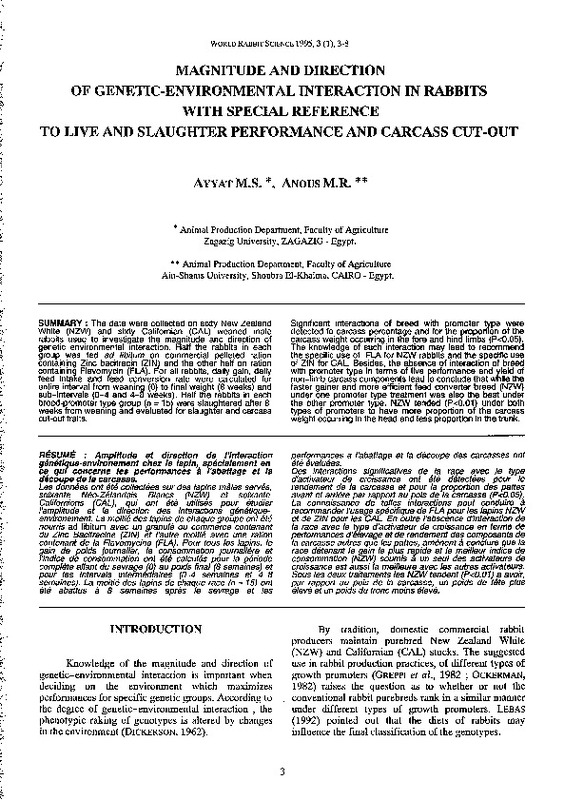JavaScript is disabled for your browser. Some features of this site may not work without it.
Buscar en RiuNet
Listar
Mi cuenta
Estadísticas
Ayuda RiuNet
Admin. UPV
MAGNITUDE AND DIRECTION OF GENETIC-ENVIRONMENTAL INTERACTION IN RABBITS WITH SPECIAL REFERENCE TO LIVE AND SLAUGHTER PERFORMANCE AND CARCASS CUT-OUT
Mostrar el registro sencillo del ítem
Ficheros en el ítem
| dc.contributor.author | Ayyat, M.S.
|
|
| dc.contributor.author | Anous, M.R.
|
|
| dc.date.accessioned | 2011-03-23T08:52:06Z | |
| dc.date.available | 2011-03-23T08:52:06Z | |
| dc.date.issued | 1995 | |
| dc.identifier.issn | 1257-5011 | |
| dc.identifier.uri | http://hdl.handle.net/10251/10524 | |
| dc.description.abstract | [EN] The data were collected on sixty New Zealand White (NZW) and sixty Californian (CAL) weaned male rabbits used to investigate the magnitude and direction of genetic environmental mteraction. Ralf the rabbits in each group was fed ad libitum on commercial pelleted ration containing Zinc bacitracin (ZIN) and the other half on ration containing Flavomycin (FLA). F'or all rabbits, daily gain, daily feed intal<e and feed conversion rate were calculated for entire interval from weaning (O) to final weight (8 weeks) and sub-intervals (0-4 and 4-8 weeks). Half tlie rabbits in each breed-i:>romoter type group (n = 15) were slaughtered after 8 weeks from weaning and evaluated for slaughter and carcass cut-out traits. Significant interactions of bread with promoter ~pe were delected fo carcass percentage and for the proport1on of the carcass weight occurring in the fore and hind limbs (P<0.05). The knowledge of such interaction may lead to recommend the specific use of FLA for NZW rabbits and the specific use of ZIN for CAL. Besides, the absence of interaction of bread with promoter type in terms of live performance and yield of non-limb carcass components lead to conclude that while the tastar gainer and more efficient feed converter bread (NZW) under one promoter type treatment was also the best under the other promoter type. NZW tended (P<0.01) under both types of promoters to have more proportion o( the carcass weight occurring in the head and less proportion in the trunk. | es_ES |
| dc.description.abstract | [FR] Les données ont été colfectées sur des lapins males servés, soixante Néo-Zélandais Blancs (NZW) et soixante Californiens (CAL), qui ont été utilises pour étudier f'amplitude et la direction des interactions génétiqueenv1ronement. La moitié des lapins de chaque groupe ont été nourris ad libitum avec un granulé du commerce contenant du Zinc Bacitracine (ZIN) et l'autre moitié avec une ration contenant de la Flavomycine (FLA). Pour tous les lapins, le gain de poids journalier, la consommation journaliere et T'indice de consommation ont été calculés pour la période complete alfant du sevrage (O) au poids final (8 semaines) et pour les intervals intermédtaires (0-4 semaines et 4-8 semaines). La moitié des /apins de chaque race (n = 15) ont été abattus a 8 semaines apres le sevrage et les performances a f'abattage et la découpe des carcasses ont été évaluées. Des interactions significatives de la race avec le type d'activateur de croissance ont été détectées pour le rendement de la carcasse et pour la proportion des pattes avant et arriare par rapport au pois de la carcasse (P<0.05). La connaissance de telfes interactions peut conduire a recommander f'usage spécifique de FLA pour les lapins NZW et de ZIN pour les CAL. En outre f'abscence d'interaction de la race avec le type d'activateur de croissance en terme de performances d'éfevage et de rendement des composants de la carcasse autres que les pattes, amenent a conclure que la race détenant le_ ~~n_ le plus rapide et le meilleur indice de consommation {NZW) soumis a un seul des activateurs de croissance est aussi la meilleure avec les autres activateurs. Sous les deux traitements les NZW tendent (P<0.01) a avoir, par rapport au pois de la carcasse, un poids de tete plus élevé et un poids du tronc moins élevé. | |
| dc.language | Inglés | es_ES |
| dc.publisher | World Rabbit Science. ICTA. UPV | es_ES |
| dc.relation.ispartof | World Rabbit Science | |
| dc.rights | Reserva de todos los derechos | es_ES |
| dc.title | MAGNITUDE AND DIRECTION OF GENETIC-ENVIRONMENTAL INTERACTION IN RABBITS WITH SPECIAL REFERENCE TO LIVE AND SLAUGHTER PERFORMANCE AND CARCASS CUT-OUT | es_ES |
| dc.type | Artículo | es_ES |
| dc.date.updated | 2011-03-23T07:44:45Z | |
| dc.identifier.doi | 10.4995/wrs.1995.233 | |
| dc.rights.accessRights | Abierto | es_ES |
| dc.description.bibliographicCitation | Ayyat, M.; Anous, M. (1995). MAGNITUDE AND DIRECTION OF GENETIC-ENVIRONMENTAL INTERACTION IN RABBITS WITH SPECIAL REFERENCE TO LIVE AND SLAUGHTER PERFORMANCE AND CARCASS CUT-OUT. World Rabbit Science. 3(1). https://doi.org/10.4995/wrs.1995.233 | es_ES |
| dc.description.accrualMethod | SWORD | es_ES |
| dc.relation.publisherversion | https://doi.org/10.4995/wrs.1995.233 | |
| dc.description.volume | 3 | |
| dc.description.issue | 1 | |
| dc.identifier.eissn | 1989-8886 | es_ES |








